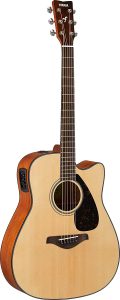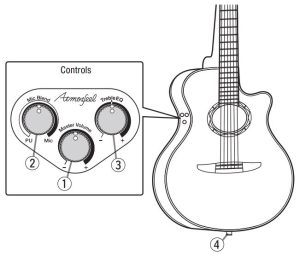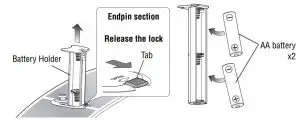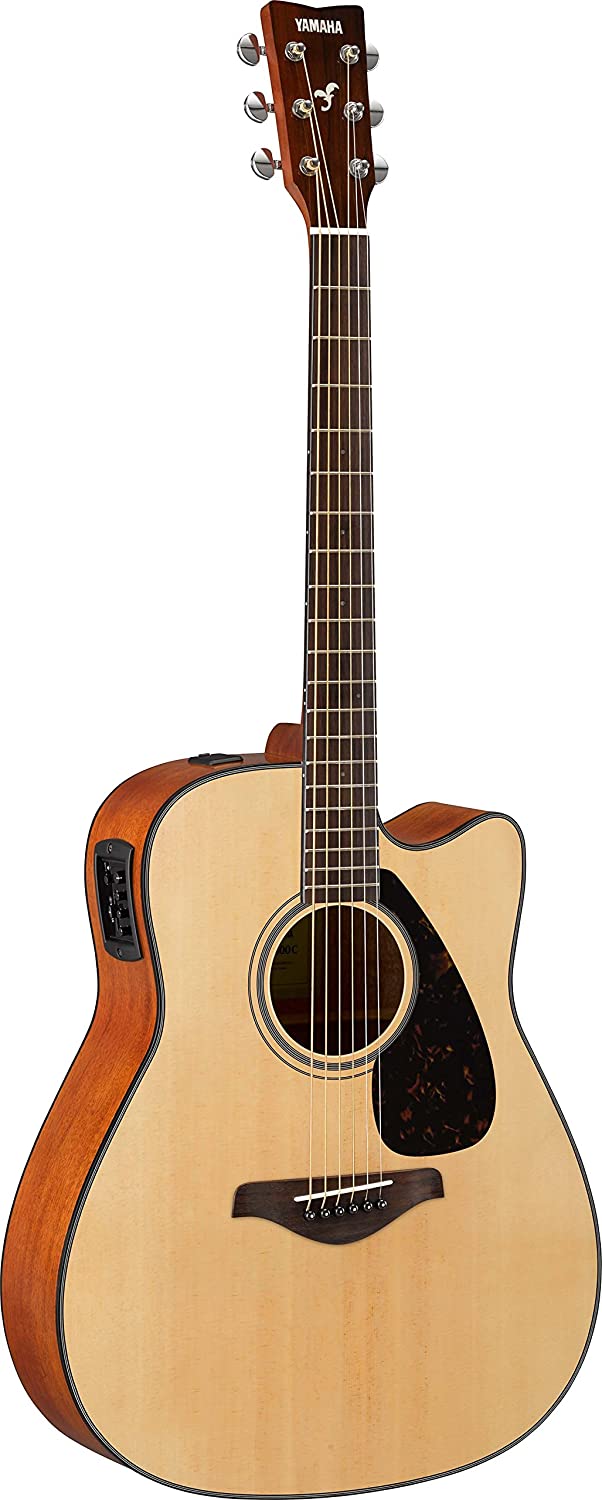![]()
YAMAHA Acoustic Electric Guitar System74N Owner’s Manual

Thank you for purchasing the Yamaha Guitar with the Atmosfeel™ technology.
Featuring Yamaha’s newly developed three-way system with built-in piezoelectric sensors, the acoustic guitar sound is captured as is, with amazing accuracy across the entire frequency range – from low to high – creating an expressive, natural warm stereophonic sound. To obtain the best performance and potential from this instrument, we encourage you to read this manual before use.
Note that this manual covers only the electronic parts of this product. For information on the other non-electronic parts, refer to the separate Acoustic Guitar Owner’s Manual.
Specifications
- System: System74N
- Pickup: Hybrid 3-way System
- Control: Master Volume, Mic Blend, Treble EQ
- Output Jack: Combination end pin/line out power switch
- Output Impedance: 1 kΩ
- Power: AA battery x2 (alkaline or nickel-metal hydride) *1
- Battery Life: Approximately 28 hours using alkaline batteries, approximately 24 hours using nickel metal hydride batteries.* 2
- Accessories: Neck adjustment hex wrench x1
*1 For best performance, we recommend the use of alkaline or nickel-metal hydride batteries.When using nickel-metal hydride batteries, please follow the instructions in Nthe manual provided with the batteries.
*2 Depends upon operating conditions.
* The contents of this manual apply to the latest specifications as of the publishing date. To obtain the latest manual, access the Yamaha website then download the manual file. Since specifications, equipment or separately sold accessories may not be the same in every locale, please check with your Yamaha dealer.
PRECAUTIONS
PLEASE READ CAREFULLY BEFORE PROCEEDINGPlease keep this manual in a safe and handy place for future reference.
![]() WARNINGAlways follow the basic precautions listed below to avoid the possibility of serious injury or even death from electrical shock, short-circuiting, damages, fire or other hazards. These precautions include, but are not limited to, the following:
WARNINGAlways follow the basic precautions listed below to avoid the possibility of serious injury or even death from electrical shock, short-circuiting, damages, fire or other hazards. These precautions include, but are not limited to, the following:
Do not open
- This instrument contains no user-serviceable parts. Do not open the instrument or attempt to disassemble or modify the internal components in any way. If it should appear to bemalfunctioning, discontinue use immediately and have it inspected by qualified Yamahaservice personnel.
Water warning
Do not expose the instrument to rain, use it near water or in damp or wet conditions, place iton any containers (such as vases, bottles, or glasses) containing liquids that might spill into any openings. If any liquid such as water seeps into the instrument, turn off the power immediately and have the instrument inspected by qualified Yamaha service personnel.
If you notice any abnormality
When one of the following problems occur, immediately turn off the power and remove all batteries from the instrument, then have the instrument inspected by Yamaha service personnel.
- It emits unusual smells or smoke.
- Some object has been dropped into the instrument.
- There is a sudden loss of sound during use of the instrument
Battery
Follow the precautions below. Failure to do so might result in explosion, fire, overheating or battery fluid leakage.
- Do not tamper with or disassemble batteries.
- Do not dispose of batteries in fire.
- Do not attempt to recharge batteries that are not designed to be charged.
- Keep the batteries separate from metallic objects such as necklaces, hairpins, coins, and keys.
- Use the specified battery type only.
- Use new batteries, all of which are the same type, same model, and made by the same manufacturer.
- Always make sure all batteries are inserted in conformity with the +/- polarity markings. – When the batteries run out, or if the instrument is not to be used for a long time, remove the batteries from the instrument.
- Keep batteries away from small children who might accidentally swallow them.
- If the batteries do leak, avoid contact with the leaked fluid. If the battery fluid should come in contact with your eyes, mouth, or skin, wash immediately with water and consult a doctor. Battery fluid is corrosive and may possibly cause loss of sight or chemical burns.
![]()
![]()
![]()
Connection
- Before connecting the instrument to other electronic components, turn off the power for allcomponents. Before turning the power on or off for all components, set all volume levels tominimum.
- Be sure to set the volumes of all components at their minimum levels and gradually raise thevolume controls while playing the instrument to set the desired listening level.
Location
- Do not place the instrument in an unstable position where it might accidentally fall over.
Handling caution
- Do not rest your weight on, or place heavy objects on the instrument, and do not useexcessive force on the buttons, switches or connectors.
* Yamaha cannot be held responsible for damage caused by improper use or modifications to the instrument.* Make sure to discard used batteries according to local regulations.* Please read the instruction manual for the external audio device such as a guitar amplifier, etc., prior to use.
Part Names/Control Descriptions


- Master VolumeTurn the Master Volume control all the way down to the minimum before connecting/ disconnecting a cable. When a cable is connected to the (4) Output Jack, the LED located inside the Master Volume lights green for one second, then the Atmosfeel™ feature will be turned on. The output level can be adjusted by turning this control to the right (clockwise) to increase the level, or to the left (counterclockwise) to reduce the level.
- Mic BlendAdjusts the level of the sound picked up with the microphones installed inside the body. Turning this control to the right (clockwise) enhances the body resonance and spaciousness of the sound. Adjusting this does not change the output level.NOTEFeedback might occur depending on the usage conditions. Use the (2) Mic Blend or the (3) Treble EQ to adjust the sound.
- Treble EQAdjusts the level of the high frequencies. Turning this control to the right (clockwise) gradually boosts the higher frequencies. Turning it to the left (counterclockwise) gradually cuts them.
- Output jack/battery holderThe output jack and battery compartment are combined into a single unit. Inserting a plug into the output jack switches the internal pre amplifier on. To prolong the life of your battery, unplug the cable from the output jack when not in use.
Replacing the Batteries
- Slide the tab on the endpin section in the direction indicated by the arrow in the diagram below to release the lock, then pull out the battery holder.
- Insert two AA batteries making sure that the battery poles are properly aligned with the polarity markings on the battery holder.
- Slide the battery holder back into the end pin section until it locks.NOTICEWhen using nickel metal-hydride batteries, take care not to damage the battery casing or poles when installing and removing the batteries.


Remaining Battery LevelThe LED located inside the Master Volume flashes red when it is time to change the batteries. Once the LED begins flashing, the remaining operation time is approximately two hours with alkaline batteries and about one hour when using nickel metal hydride batteries (Time varies according to operating conditions). Please replace the batteries as soon as possible.
Manual Development Group© 2019 Yamaha Corporation
Published 05/2021
[xyz-ips snippet=”download-snippet”]


